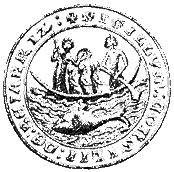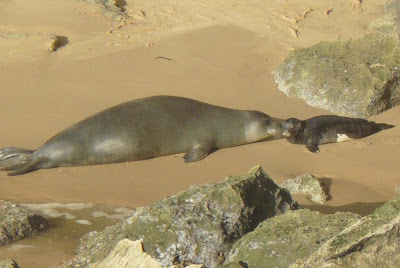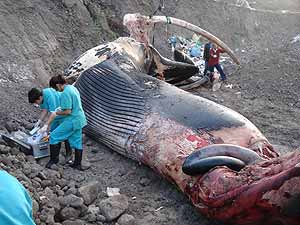This is a bit from The Basque History of the World by Mark Kurlansky, an interesting if somewhat nationalistic portrait of that remarkable corner of the Iberian Peninsula. There’s a big section on whaling, from which I leave you all:
 
Seal of the Basque town of Biarritz, 1351, with whaling scene and two-flued harpoon. (http://www.whalecraft.net/History.html)
An important feature of the Basque whale was that, like the sperm whale, but unlike many whale species, it floated when dead. The whale’s back shone obsidian black in the water, though the belly was a brilliant white. Averaging about fifty to sixty feet in length, a quarter of which was the huge head, a single animal could weigh more than sixty tons. Such a whale would yield thirty tons of blubber, which could be cooked down to an oil valued for centuries as fuel. Most coastal Basque communities established facilities along their beaches for cooking down whale blubber. As with most things Basque, it is not certain when this oil trade began, but in 670, at the end of the age of the Visigoths, there was a documented sale in northern France by Basques from Labourd of forty pots of whale oil……
……The first commercial whale hunters were the seventh- and eighth-century Basques, who found an eager market for this meat in Europe. Whale meat became a staple of the European diet partly because the Catholic Church forbade the eating of “redblooded” meat on holy days-about half the days on the calendar including every Friday-arguing that it was “hot,” associated with sex, which was also forbidden on holy days. But meat that came from animals-or parts of animals-that were submerged in water, including whale, fish, and the tail of the beaver, was deemed “cold” and therefore permitted. So with the exception of beaver tails and the occasional seal or porpoise, whale was the one allowable red meat. The Basques became the great providers of this holy red meat. They sold the leaner meat fresh or preserved in salt. Fattier parts were cured like bacon. In Paris, where these cuts were a Lenten specialty, they were known as craspois. Tongues, fresh or salted, were regarded as a particular delicacy and served with peas. Being the choicest part, the only good part, according to some medieval writers, whale tongues were often demanded by local church or government officials as tribute. The port of Bayonne jealously guarded its monopoly on the tongue trade.

Replica of a txalupa, the original Basque whaling boat (http://www.pasaiabai.com/cultura/2006/mayo/1-mayo-ontziola.htm)
In the seventh century, the Basques, no longer content to await for ailing whales to beach themselves, built stone whalespotting towers along the coast from Bilbao to Bayonne, manning them between October and March. One still remains on a mountaintop near San Sebastian and another in Guethary in Labourd. The whale’s undoing was the fact that it is a lunged mammal and must rise to the surface to breathe. When it does, a tall column of vapor is released. Spotting the spout of an approaching whale off the coastline, the lookout in the tower would let out a prolonged yell. His shouts were actually coded signals that told whalers the exact type of whale sighted, and whether it was a single whale or in a group. Five oarsmen, a captain, and a harpooner would then row out in a lightweight vessel.
The oarsmen would row as silently as possible, muffling the oars in their locks and even the oar blades in the water with oiled cloth. Then, having sneaked up on the unsuspecting giant foundering along the coast, they would strike suddenly with wooden-handled spears and harpoons. The oarsmen had to row, close enough to the whale for the harpooner to plant the har•
goon deeply into the body just below the head. Harpooning became the trade of the largest, strongest men. After harpooning the whale, the oarsmen had to row furiously in reverse, turning a fast circle, for an enraged whale could kill a dozen men with a flick of its huge tail. Or, instead of turning on its attackers, the whale might try to dive to the safety of great depths, dragging men and boats with it. The whale would dive with harpoon, line, and buoys until, out of breath, it had to furiously resurface, only to be harpooned again. The process was repeated numerous times until the whale spouted blood and died or the whalers capsized and drowned. Sometimes the boat and fishermen would just sink under the weight of the wet ropes.
By the late thirteenth century, whales marked the town seals of Bermeo and Fuenterrabia. Among the other towns that included whales in their town seals were Biarritz, Hendaye, Guetaria, Motrico, and Lequeitio. Not only did these towns keep the whale on their seals, but, from the use of whaling launches, they developed an early and enduring passion for rowing regattas.
More books about the Basque Country I have read
The Basque Country: A Cultural History by Paddy Woodworth: Full of fascinating facts. An excellent balanced account.









